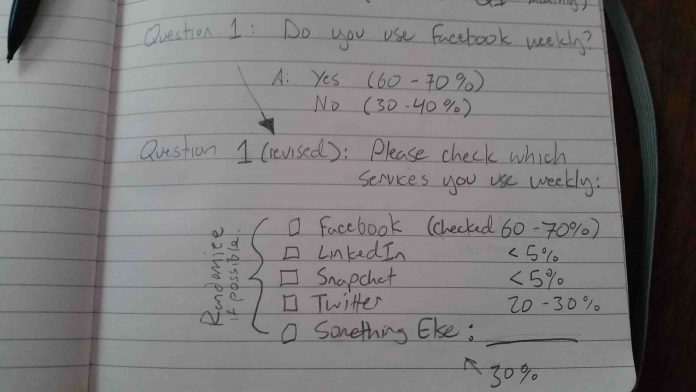It’s easy to begin the survey writing process by brainstorming a list of questions to ask. So sit down, and think through what you want to learn from your survey. Starting with a list of answers and turning them into survey questions will ensure that you include all of the questions you need, and word them in a way that will get effective answers. It will also prevent you from inflating your survey with questions that don’t matter.
You will also need to choose the best survey company to work with. There are several options for those starting to gather customer feedback. While it may seem like a good idea to go with the trend of using the Google consumer surveys tool you should do your homework to find the best survey tools available.
Not all survey companies are the same, and you want a trusted name with plenty of options for survey customization, demographic targeting options and more.
Getting Answers: Survey Question Types
As you’re turning your answers into questions, you’ll need to think about what type of questions you need to ask. Surveys aren’t just about yes and no questions, however. You’ll find dozens of question types in most survey apps. Choose an option that will provide the best and most detailed answers you are looking for.
Some examples include
Categorical Questions
If you’re looking for a simple count, such as “35% of people said ABC” or “20% of men and 24% of women…” then there’s a variety of question types you can use such as:
- Yes/No
- Checkbox
- Multiple Choice
These types of questions are also called “nominal” questions.
Ordinal Questions
When question responses have a clear order (like “Income of $0-$25K, $26K-40K, $40K+”), we call them “ordinal” questions. You can collect ordinal data by using:
- Drop-down Boxes
- Interval/Ratio Questions
- Ranking Scale
Analysis of ordinal questions is similar to analysis for nominal questions: you can get counts and percentages. You cannot find averages or test correlations with ordinal-level data.
Textbox/Open Ended
If you are looking to gain a more detailed knowledge of your customers’ opinions, this is the best option. While Nominal and Ordinal Questions can prompt survey takers with a list of choices, text boxes let them decide the answers.
Best Practices for Writing Survey Questions
Now that you have a list of the answers you’re looking for, it’s time to start writing questions for your survey. Before you write pages full of questions, you’ll need to remember to follow these tips to build effective, powerful survey questions:
Use Simple, Direct Language
Avoid using big words, complicated words, and words that could have multiple meanings. Your question should be short, simple, and clear.
Be Specific
Some concepts may mean different things to different people. Try to be as specific as possible when you ask questions. For example, instead of asking “Do you exercise regularly?” you could ask “How many days per week, on average, do you exercise?” This gives you a more precise, objective answer.
Break Down Big Ideas into Multiple Questions
Another way to deal with broad concepts that mean different things to different people is by breaking them down into multiple, more tangible questions. Each of your survey questions should ask one thing, and one thing only.
It seems simple enough. But many survey writers fall into the “double-barreled” question trap. Or loading 2 questions into one. A better option is to split the question into two separate ones.
Avoid Leading Questions
Sometimes, researchers’ opinions can seep into survey questions, subtly encouraging respondents to answer in a certain way and compromising survey results. For example, asking “Do you believe our cafe should cut the flatbread pizza to add a new cheeseburger?” would likely prompt a different answer than asking, “Should the cafe add a new burger to their menu?” even though both questions are related to the same topic.
To avoid leading questions, ask a friend or colleague to review your survey for any questions that seem like they might be leading the surveyed individual to give a specific answer. If your friend can guess what kind of answer you’re looking for, consider rewriting the question.
Use More Interval Questions
One simple way to take your survey from good to great is by changing your Yes/No and multiple choice questions to interval questions. Make a statement, and ask people to answer it on a 1-5 or 1-7 scale, like “Strongly Disagree, Disagree, Neither Agree nor Disagree, Agree, or Strongly Agree.”
You’ll instantly upgrade the level of analysis you can perform on your results. Researchers use scales of 1-5 or 1-7 because they do a good job capturing variation in answers, without causing information overload for the respondent.
Avoid Bias
Survey response bias is a sad but important reality to consider when writing surveys. Asking for information like gender, race, or income at the beginning of a survey can influence how people respond to the rest of the survey. Most survey writers prevent bias and stereotype threat by asking sensitive questions; such as those pertaining to gender, race, and income at the end of surveys.
Bias can also happen when you interpret the survey. Without even knowing it, you might treat one person’s opinion differently simply because of their demographic answers. In some cases, you might not want to gather any demographic data at all to create a totally anonymous survey, something common in academic research.
can you include a conclusion to summarize this article?

